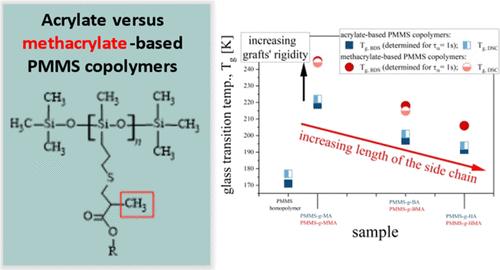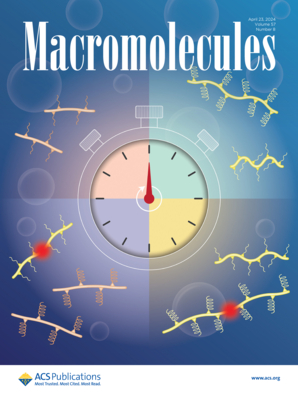接枝刚性对基于 PMMS 的聚合物刷在常温和高压下动态行为的影响
IF 5.1
1区 化学
Q1 POLYMER SCIENCE
引用次数: 0
摘要
本文研究了以聚(巯丙基)甲基硅氧烷(PMMS)为基础的聚合物刷的分子动力学。在常温和高压条件下,巯基与不同烷基链长度的同源柔性丙烯酸酯(丙烯酸酯基 PMMS 共聚物)和刚性更强的甲基丙烯酸酯(甲基丙烯酸酯基 PMMS 共聚物)单体接枝。研究发现,与其他体系相比,聚甲基丙烯酸甲酯均聚物的玻璃化转变温度(Tg)明显较低。此外,令人惊讶的是,在甲基丙烯酸酯接枝共聚物中存在两个弛豫过程(α 和 α′),而在各种丙烯酸酯接枝的体系中,过冷相只有一个弛豫过程。补充性流变学研究表明,较快的α过程来自段运动,而α′在机械响应中未被检测到。进一步的高压实验表明,在甲基丙烯酸酯基 PMMS 共聚物中,无论施加的压力 p 如何,分段模式和 α′ 模式之间都存在叠加。这一结果表明,后一过程可被视为子劳斯模式,或者可能源于刚性极性侧链(接枝)的介电主动弛豫。此外,通过分析高压数据,我们可以估算出玻璃化转变温度的压力系数 dTg/dp,与 PMMS 均聚物相比,聚合物刷的压力系数要高得多。有趣的是,甲基丙烯酸酯接枝共聚物的 dTg/dp 值略高于丙烯酸酯基 PMMS 共聚物,这可能是由于两组材料的柔韧性/刚性不同,因为所有研究材料的均聚物主链(Nbb ∼ 12)和侧链(Nsc = 1)的聚合度相同。然而,对于两组研究的体系,dTg/dp 值并不随链的长度而变化。这一出乎意料的结果肯定与所研究的接枝共聚物的结构以及接枝(丙烯酸酯/甲基丙烯酸酯的衍生物)的特性有关。本文提供的数据扩展了我们对不同分子结构在常压和高压下对聚合物动力学影响的认识。本文章由计算机程序翻译,如有差异,请以英文原文为准。

The Influence of Graft Rigidity on the Dynamical Behavior of PMMS-Based Polymer Brushes at Ambient and High Pressures
In this paper, we investigated the molecular dynamics of polymer brushes based on poly(mercaptopropyl)methylsiloxane (PMMS), in which the thiol group was grafted with different homologous flexible acrylates (acrylate-based PMMS copolymers) and more rigid methacrylate (methacrylate-based PMMS copolymers) monomers of varying lengths of alkyl chain under ambient and elevated pressure conditions. It was found that the glass transition temperature, Tg, of PMMS homopolymer is significantly lower compared to the other systems. Moreover, surprisingly, in the methacrylate-grafted copolymers, there are two relaxation processes (α and α′), while in the systems grafted with various acrylates, only a single process is present in the supercooled phase. Complementary rheological investigations indicated that the faster α process comes from the segmental motions, while α′ is not detected in the mechanical response. Further high-pressure experiments showed that there is a superposition between segmental and α′ modes irrespective of applied pressure, p, in methacrylate-based PMMS copolymers. This result suggests that the latter process might be considered as a sub-Rouse mode, or alternatively, it may originate from the dielectric active relaxation of the rigid polar side chain (grafts). Moreover, analysis of the high-pressure data allowed us to estimate the pressure coefficient of the glass transition temperature, dTg/dp, which was much higher for polymer brushes with respect to the PMMS homopolymer. Interestingly, the values of dTg/dp for methacrylate-grafted copolymers are slightly higher compared to acrylate-based PMMS copolymers, which may be due to the different flexibility/rigidity of both groups of materials as all examined materials have the same degree of polymerization of homopolymer backbone (Nbb ∼ 12) and side chain (Nsc = 1). However, for both groups of studied systems, dTg/dp values did not scale with chain length. This unexpected result must be related to the structure of the studied grafted copolymers and the character of grafts, derivatives of acrylates/methacrylates. The data presented here extend our knowledge of the influence of the architecture of different molecules on the dynamics of polymers at ambient and high pressures.
求助全文
通过发布文献求助,成功后即可免费获取论文全文。
去求助
来源期刊

Macromolecules
工程技术-高分子科学
CiteScore
9.30
自引率
16.40%
发文量
942
审稿时长
2 months
期刊介绍:
Macromolecules publishes original, fundamental, and impactful research on all aspects of polymer science. Topics of interest include synthesis (e.g., controlled polymerizations, polymerization catalysis, post polymerization modification, new monomer structures and polymer architectures, and polymerization mechanisms/kinetics analysis); phase behavior, thermodynamics, dynamic, and ordering/disordering phenomena (e.g., self-assembly, gelation, crystallization, solution/melt/solid-state characteristics); structure and properties (e.g., mechanical and rheological properties, surface/interfacial characteristics, electronic and transport properties); new state of the art characterization (e.g., spectroscopy, scattering, microscopy, rheology), simulation (e.g., Monte Carlo, molecular dynamics, multi-scale/coarse-grained modeling), and theoretical methods. Renewable/sustainable polymers, polymer networks, responsive polymers, electro-, magneto- and opto-active macromolecules, inorganic polymers, charge-transporting polymers (ion-containing, semiconducting, and conducting), nanostructured polymers, and polymer composites are also of interest. Typical papers published in Macromolecules showcase important and innovative concepts, experimental methods/observations, and theoretical/computational approaches that demonstrate a fundamental advance in the understanding of polymers.
 求助内容:
求助内容: 应助结果提醒方式:
应助结果提醒方式:


